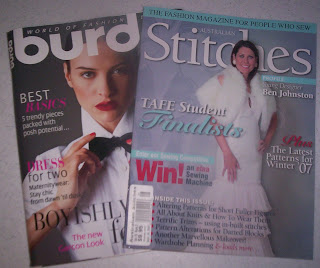I tried a new method of attaching my waistband. I don't like it. I usually use the method on page 116 of
Pants for Real People (PFRP). It's a combination of a regular waistband and an elastic waistband.
In real elastic waistband, the fabric would measure the same circumference around the hips and waist, with only the elastic bringing in the fabric to the waist measurement. In a real waistband, the fabric measures more around the hips and is brought in with darts and curves at the waist. The waist is fitted and the zipper opens the smaller waist circumference to go over the larger hips.
The combo method combines the darts, curves, and zipper to allow less fabric gathered at the wast, while it also uses elastic to cinch in the bit of extra waist ease. I have many pants where I've used the PFRP page 116 method. It gives me the best of both worlds. I often think of the elastic as the interfacing of the waistband. It gives it a rigidness that is firm, but flexible.
I saw something somewhere that may have been this exact new method, but I didn't read it and don't remember it enough to be sure. It got my mind thinking that this would be a good new method to try. I was wrong.

I started by serging one raw edge of my waistband and attaching the other raw edge to the pants.

Then I attached the ends of the elastic to the seam allowance of the pants, lining up one edge with the edge of the zipper and letting the other edge hang over for the under flap. I did not stretch the elastic in these spots. I could not decide if it mattered which side I attached the elastic to -- the inside or the outside. I attached it inside, but it would have been better attached to the outside. I'll tell you why when we get to it.

Next I stretched the elastic as I sewed it to the seam allowance. This turned out to be the fatal flaw. The elastic did not shrink back to its original size.

Then I sewed the ends neatly by hand. This is where I discovered that had I put the elastic on the outside of the pants, the seam allowance would have folded over it and covered it. I had to hand sew carefully to cover the elastic. It worked fine, but the elastic on the other side would have been a tiny bit easier.

Then I stitched in the ditch. As I imagined, this step was much easier than the PFRP technique. It was the desire to avoid the anxiety of accidentally stitching through my elastic on this step that prompted trying this new method.

The final waistband looks fantastic, but it left the pants too big in the waist. In PFRP, the elastic casing is sewn with the elastic in there, attached only at one end. Then the loose elastic which is hanging out is pulled to fit your waist while you wear them. It's fool proof on final fit.
In the end, this method was easier, but not worth the loss of fit. I'll go back to page 116 and just get through the anxiety. Funny thing is, I've never sewn through the elastic accidentally!



 I started by serging one raw edge of my waistband and attaching the other raw edge to the pants.
I started by serging one raw edge of my waistband and attaching the other raw edge to the pants. Then I attached the ends of the elastic to the seam allowance of the pants, lining up one edge with the edge of the zipper and letting the other edge hang over for the under flap. I did not stretch the elastic in these spots. I could not decide if it mattered which side I attached the elastic to -- the inside or the outside. I attached it inside, but it would have been better attached to the outside. I'll tell you why when we get to it.
Then I attached the ends of the elastic to the seam allowance of the pants, lining up one edge with the edge of the zipper and letting the other edge hang over for the under flap. I did not stretch the elastic in these spots. I could not decide if it mattered which side I attached the elastic to -- the inside or the outside. I attached it inside, but it would have been better attached to the outside. I'll tell you why when we get to it. Next I stretched the elastic as I sewed it to the seam allowance. This turned out to be the fatal flaw. The elastic did not shrink back to its original size.
Next I stretched the elastic as I sewed it to the seam allowance. This turned out to be the fatal flaw. The elastic did not shrink back to its original size.



 I also received my Burda World of Fashion, quickly joined by a copy of Stitches, which I picked up when I went out to buy that pesky zipper I was missing. Stitches appears to be a very good magazine. It has detailed articles about garment sewing with many diagrams and photographs. I've only had time to flip through it so far, but I'm impressed.
I also received my Burda World of Fashion, quickly joined by a copy of Stitches, which I picked up when I went out to buy that pesky zipper I was missing. Stitches appears to be a very good magazine. It has detailed articles about garment sewing with many diagrams and photographs. I've only had time to flip through it so far, but I'm impressed.


